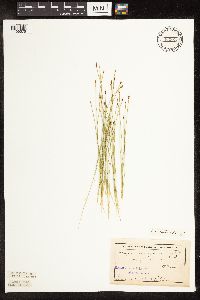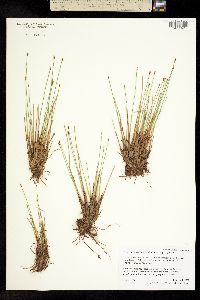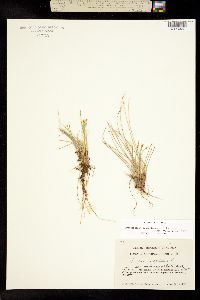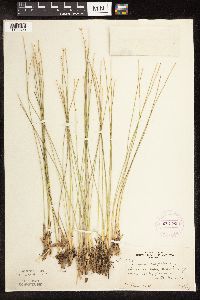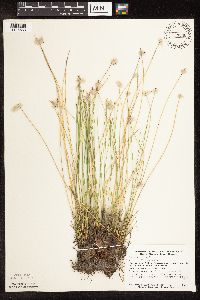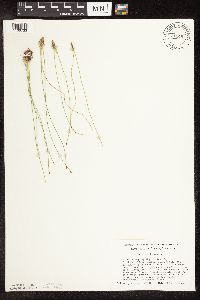Trichophorum cespitosum
|
|
|
|
Family: Cyperaceae
Tufted Leafless-Bulrush
[Baeothryon caespitosum (L.) A. Dietr., moreBaeothryon cespitosum (L.) A. Dietr., Scirpus bracteatus Bigelow, Scirpus caespitosus Willd. ex Kunth, Scirpus caespitosus var. callosus Bigelow, orth., Scirpus caespitosus var. delicatulus Fernald, orth., Scirpus cespitosus L., Scirpus cespitosus var. callosus Bigelow, Scirpus cespitosus var. delicatulus Fernald, Trichophorum bracteatum , Trichophorum caespitosum (L.) Hartm., orth., Trichophorum caespitosum var. callosum (Bigelow) Mohlenbr., orth., Trichophorum cespitosum subsp. cespitosum] |
Plants densely cespitose; rhizomes absent. Culms grooved, terete, 5-45 cm, smooth. Leaves: basal sheaths brown; distal leaf sheaths concave at mouth; blades 1.5-8 × 0.3-0.4 mm, much shorter than culms at flowering and fruiting. Inflorescences: spikelets 3-9-flowered, 3.3-7 × 1.2-3 mm; bracts equaling spikelets, 3.3-4.5 mm, apex with awn less than 1 mm. Spikelets: scales reddish brown to dark brown, apex mucronate to acute. Flowers: perianth bristles 6, brown, terete, equaling or exceeding achenes, smooth to scabrous; anthers 1.5-2.6 mm. Achenes compressed trigonous, 1.4-1.7 × 0.6-0.9 mm. 2n = 104. Fruiting summer (May-Aug). Open, wet, rocky or peaty meadows, fens, bogs, shores; 0-2100 m; Greenland; Alta., B.C., Man., N.B., Nfld. and Labr., N.W.T., N.S., Nunavut, Ont., P.E.I., Que., Sask., Yukon; Alaska, Idaho, Maine, Mont., N.H., N.Y., N.C., Oreg., S.C., Tenn., Utah, Vt., Wash.; Europe; montane c Asia, boreal w Asia. Segregates defined on the basis of characters such as the number of flowers per spike and distal leaf sheath morphology have been recognized at varietal or subspecific ranks in North America and Europe. In North America, at least, these characters are variable within populations and appear to have no geographic integrity. North American plants of Trichophorum cespitosum appear to be identical to subsp. cespitosum (cf. R. A. DeFilipps 1980). No cytological differences have been detected between European and North American populations; all counted plants have 2n = 104 or n = 52.
Perennial herb, densely tufted 5 - 45 cm tall Leaves: more or less basal. Basal sheaths brown, upper leaf sheaths concave at the mouth. Blades 1.5 - 8 mm long, under 0.5 mm wide, much shorter than culms (at flowering and fruiting), linear, keeled beneath. Inflorescence: a solitary, terminal spikelet, subtended by a scale-like bract. Bract more or less upright, 3 - 4.5 mm long, bearing a tiny point at the apex. Flowers: minute, subtended by a floral scale, lacking sepals and petals, bearing six bristles. Bristles straight, brown, equal to or longer than achene, circular in cross-section, smooth to rough. Stamens three, exserted. Anthers 1 - 2.5 mm long. Pistil one. Style linear, three-cleft, base persistent. Fruit: a one-seeded achene, brown, about 1.5 mm long, 0.5 - 1 mm wide, compressed three-sided. Culm: 5 - 45 cm long, circular in cross-section, grooved, solid. Spikelets: solitary, 3 - 7 mm long, 1 - 3 mm wide, with three to nine floral scales. Floral scales spirally arranged, reddish brown to brown, egg-shaped with a pointed apex that sometimes bears a tiny point. Similar species: No information at this time. Flowering: late May to August Habitat and ecology: Rare in the Chicago Region, and characteristic of fens in the northwestern sector. Occurence in the Chicago region: native Etymology: Trichophorum comes from the words trichos, meaning hair, and probably phoros, meaning bearing. Cespitosum means "in tussocks or tufts." Author: The Morton Arboretum Stems very densely tufted on a short, freely rooting rhizome, 1-4 dm, smooth, subterete, clothed with several conspicuous, light brown scale-lvs at the base, and commonly with a single more normal lf a little higher, this with a typical sheath but the blade slender and only 4-6 mm; spikelet 1, terminal, brown, 4-6 mm, several-fld, the invol represented only by 2 or 3 empty scales at the base (these often deciduous as the spikelet approaches full maturity), the lowest scale with a prominent, broad, blunt awn 1-3 mm that may shortly surpass the spikelet; scales ovate, acute to shortly mucronate; bristles 6, very fragile, usually shortly surpassing the achene; anthers 1.1-2.5 mm; achene trigonous, brown, 1.5-1.7 mm, minutely apiculate; 2n=104. Tundra, alpine mats, and acid bogs; circumboreal, s. in Amer. to the mts. of N. Engl. and N.Y. and to n. Ill., Minn., Utah, and Oreg.; disjunct in the mts. of N.C. and Tenn. Fr June-Aug. (Trichophorum c.) Gleason, Henry A. & Cronquist, Arthur J. 1991. Manual of vascular plants of northeastern United States and adjacent Canada. lxxv + 910 pp. ©The New York Botanical Garden. All rights reserved. Used by permission. |















































